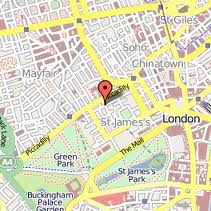St. James’s Palace
My pictures of London’s St. James’s over the years show astonishing similarity of views, but I keep trying to capture the essentials of the area and manage to fail. St. James’s is the area around St. James’s Palace and was once, in the reign of the Stuarts, where “everyone” lived. Before Kensington, before Belgravia, before Mayfair, St. James’s Square was — and is — the Place To Be. Only the most exclusive clubs, the most distinguished businesses and retailers, the most luxurious hotels…the creme de la creme of London.
map of St. James’s
St. James’s is bordered on the east by Haymarket, on the north by Piccadilly, on the south by the Mall and St. James’s Park, and on the west by Green Park. Once part of the royal hunting grounds itself, like the Parks, the area of St. James’s was granted by Charles II to Henry Jermyn (Earl of St.Albans) to develop as a residential neighborhood adjacent to St. James’s Palace.
Last June (2011), I watched the Queen and Royal Family, accompanied by a FEW of her Guards, parade from Buckingham Palace along the Mall toward the parade ground at Horse Guards for the annual Trooping the Colour. See this blog of July 30, 2011, for more.
The Queen was accompanied by the Duke of Edinburgh, beside her and following were Prince Charles, Prince William, and Princess Anne on horseback.in their uniforms as Colonels of Guards regiments.
While the Queen was reviewing her troops, I took the opportunity to wander around St. James’s and snap more pictures. I walked up the steps from the Mall between the two large buildings that comprise Carlton House Terrace, once the site of the Prince Regent’s fantastic Carlton House, demolished in 1825.
The large townhouses which comprise the Terrace wings and Carlton Gardens are mostly offices now but once housed distinguished figures such as Lord Palmerston.
Waterloo Place is not much more than a parking lot, sadly.
Waterloo Place with Duke of York Column
The large monument is to the Duke of York, son of George III and brother of George IV.
Waterloo Place was to be the terminal point of the great development of Regent Street, stretching from the Mall to Regent’s Park, as designed by architec
t John Nash for George IV, and for which Carlton House itself was demolished. But unlike the nearby Trafalgar Square, it has never become a public gathering place of importance.
t John Nash for George IV, and for which Carlton House itself was demolished. But unlike the nearby Trafalgar Square, it has never become a public gathering place of importance.
Looking in the other direction, north, up Regent Street.
One one side of Waterloo Place is the Traveller’s Club and on the other is the Athenaeum with its garden. I assume all the distinguished members were at Horse Guards, for it appeared to be rather deserted.
Atheneaum, with equestrian statue of Edward VII
Athenaeum and Garden
Athenaeum Entrance
Things were pretty quiet with everyone watching for the Queen’s return, so I turned west and walked down Pall Mall.
Above, looking west on Pall Mall with London’s ever present traffic diversions
At 87 Pall Mall is the elegant facade of Schomberg House with its Coade Stone figures supporting its portico.
Just a few steps farther is the handsome 79 Pall Mall with its lovely window set off by pink geraniums looking out at the busy street.
A building on this site, still part of the Crown Estate, was given to Nell Gwynne (1650-1687), the little orange seller who became the Restoration Theatre’s most famous actress — as well as being one of the mistresses of Charles II.
I’ll continue with my St. James’s Views soon…next stop, Marlborough House and St. James’s Palace. How I long to return…there’s so much more to explore in just this one small area of London.

Those pictures are really good. Wish I had been there, too!
How clever of you to take your photos when queen was otherwise engaged!